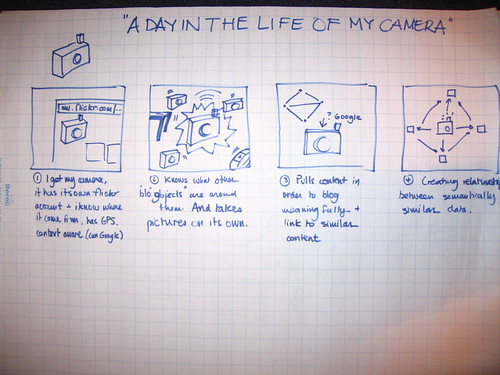Lately I’ve been testing new (to me) feed readers … (BlogBridge, Awasu, and the newest version of FeedReader(3)); an activity that sent me back to my neglected collection of feeds. I miss having the time to read and comment, read and blog, blog and talk with my virtual colleagues and critics. Obviously I read and found this:
On Anne Gallaway’s blog (Purse Lip and Square Jaw), there is an entry on the subject of “blogjects”. Not really on `blogjects’ but she takes the word/concept to task. What are blogjects? A videocast and a picture can help make sense of what these are.
 Essentially, the term is meant to represent objects with certain built in capabilities to interact with the environment; designed to collect information and feed it back to the user. Here they speak of GPS mapping and googling attached to : i.e. a camera.
Essentially, the term is meant to represent objects with certain built in capabilities to interact with the environment; designed to collect information and feed it back to the user. Here they speak of GPS mapping and googling attached to : i.e. a camera.
In what they call the Internet of things (seen as post web 2.0), objects are anthropomorphised, they literally ‘talk back’.
The Internet of Things is the underpinnings for a new kind of digital, networked ecology in which objects become collaborators in helping us shape our individual social practices towards the goal of creating a more livable, habitable and sustainable world. “Blogjects” — or objects that blog — captures the potential of networked Things to inform us, create visualizations, represent to us aspects of our world that were previously illegible or only accessible by specialist.
As Anne Galloway remarks, Bruno Latour’s Actor Network theory (ANT) is certainly the theory that seems to best represent such actants; the term Latour used to signify people and/or object agency. Actant as a term collapses both into one: no more hierarchy, instead both have equal powers of shaping but they remain separate yet interconnected.
ANT is not focused on the objects says Anne Gallaway, but instead Latour foregrounds the links or relationships these make possible (the network they map out). I agree with Anne’s reading, in that it’s the interdependant connectivity made possible by the translations of actants, that lead to versions of the social. Latour in his latest book mentions there is no social a priori, it is constructed through translations, mapped out from the center out, according to the actants that create the signifying network organised around a controversy/issue/event. (Reviews here).
Instead the notion of blogject seems to collapse person-machine into one, in more of a cyborg type of entity, than a Latourian actant which retains more of its separate yet interconnected reality. The blogject is anthropomorphised, it “thinks” and “communicates”; while the cybord is a human that is machine like. Blogjects seem to fit nicely in Donna Haraway’s cyborg world: “Haraway’s ideal “cyborg world” consists of people living together, unafraid of their joint kinship with animals and machines.” The kinship is forgotten for a fetishised object as Anne remarked.
I too object to the Internet of things being seen as “a renaissance of objects”. Objects have always informed and participated in significant ways in our world. The digital object is just another “species”. (Knorr Cetina also has much to say on this). How I read blogjects (and surface reading it is at this point) and the explanation provided is as follows: they carry their own DNA (to carry through with the anthropomorphism), reveal traces of human/object activity, while feeding back contextual information that is otherwise hidden, accessible only to experts in the past or invisible because of our human limitations.
The tools/objects can help us see more of the context, the history, and even the background and as such extend our information source and perhaps enhance cognitive potential. But what I or You do with what you now have access to and are able to see can be something completely other than connecting to humans in any significant way or creating “sustainable and habitable worlds”. That’s a big technological leap of faith.
What blogjects seem to represent well are various traces of our human/object activities, what they call ‘cataloguing the weak signals” (see slides of presentation).This newer ‘legibility” of traces of what use to be opaque or invisible also implies new types of literacies; a literacy of diverse codes, genres and symbols. It also implies more demands on our already stretched to max attention. Without some purpose, some type of practical use, this is just one other type of information, in an already saturated information world.
As an ordinary user, a citizen doing my thing, I can choose to tune out, or never tune in in any significant way, watching a trend go by without taking part in it. In business certainly. In research, and specialized uses, the many types of mapping made possible by technology is quite useful. (See DontClick.it and see the mouse traces of past users). In education? perhaps, once schools ramp up to systematically teach information-media literacies across the board.
And furthermore, if blogjects don’t partake in actual blogging, that is publishing person generated text we can read, instead of bouncing snippets of all kinds of data, than a more apt term could be “datajects” (sounds too much like reject) or “infojects” or even “mediajects”. What do you think?